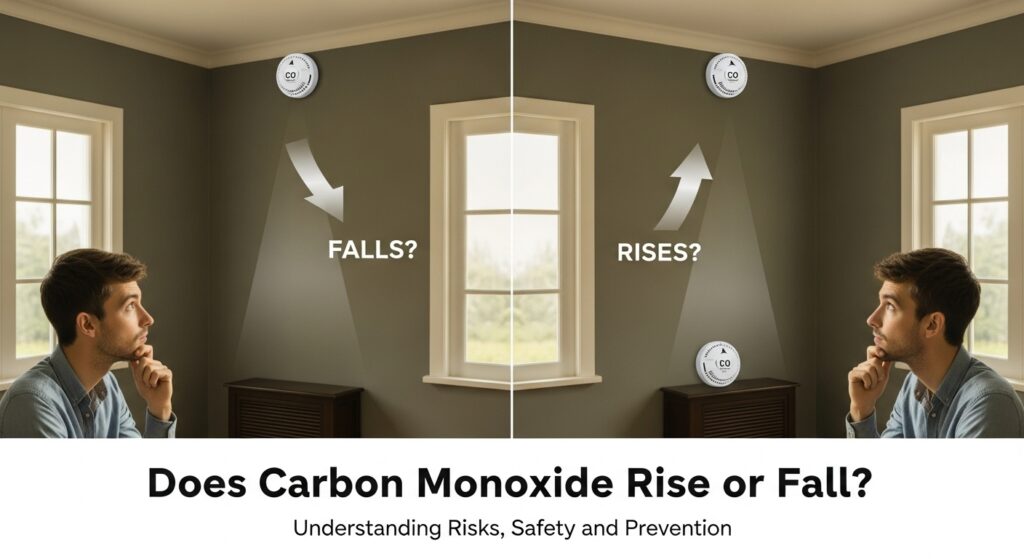In today’s rapidly evolving world, safety in the home and workplace is no longer just a matter of convenience—it is a critical responsibility. Among the many hazards that can compromise health, carbon monoxide (CO) stands out as particularly dangerous because it is colorless, odorless, and often undetectable without specialized equipment. Understanding the behavior of this gas, including whether it rises or falls, is essential for protecting yourself, your family, and your community.
This article explores the science behind carbon monoxide, answers the critical question does carbon monoxide rise or fall, and highlights strategies for prevention, detection, and safety.
Understanding Carbon Monoxide
Carbon monoxide is a poisonous gas produced by the incomplete combustion of carbon-containing fuels. Common sources include:
-
Gas furnaces, water heaters, and stoves
-
Wood-burning fireplaces or stoves
-
Vehicle exhaust in attached garages
-
Charcoal grills or generators used indoors
CO is particularly dangerous because it binds to hemoglobin in the blood more efficiently than oxygen, reducing the blood’s ability to carry oxygen to vital organs. Symptoms of exposure range from headaches and dizziness to confusion, loss of consciousness, and in extreme cases, death.
Does Carbon Monoxide Rise or Fall?
A key safety consideration for carbon monoxide is understanding its behavior in air. Many people wonder whether carbon monoxide rises or falls. The answer is: carbon monoxide is slightly lighter than air, but it mixes thoroughly with the air rather than strictly rising or falling.
Air is a mixture of gases, including nitrogen (78%) and oxygen (21%), with a small fraction of other gases. CO has a molecular weight of 28.01 g/mol, slightly less than air’s average of approximately 28.96 g/mol. This means that while CO is marginally lighter than air, in practical terms, it disperses evenly throughout enclosed spaces due to air currents, temperature differences, and ventilation.
Implications:
-
Installing CO detectors at multiple heights is essential, rather than assuming the gas will rise to the ceiling or settle on the floor.
-
Areas near sleeping spaces, living rooms, and utility rooms should have properly placed detectors to maximize early warning.
The Science Behind CO Dispersion
Several factors affect how carbon monoxide behaves indoors:
1. Ventilation and Airflow
Air movement caused by HVAC systems, fans, or open windows promotes mixing. Even though CO is slightly lighter, airflow ensures it does not simply accumulate at one height.
2. Temperature Differences
Warm air rises, carrying CO upward in some situations, but as it cools and disperses, it becomes evenly distributed.
3. Room Geometry
High ceilings or multi-level spaces can affect concentration, but CO can still travel between floors if doors are open or ventilation exists.
Understanding these dynamics is crucial because it informs where to place detectors and how to respond to potential leaks.
Why CO Detection Matters
Carbon monoxide is nicknamed the “silent killer” because exposure can occur without obvious warning signs. Knowing whether carbon monoxide rises or falls directly impacts detection and prevention strategies.
Key safety measures include:
-
CO Detectors: Install at least one on each floor and near sleeping areas. Some manufacturers recommend placing detectors at eye level, while others advise on ceilings; following local regulations is critical.
-
Regular Maintenance: Furnaces, gas stoves, and water heaters should be inspected annually to prevent leaks.
-
Ventilation: Ensure that chimneys, vents, and exhausts are clear and functional.
-
Emergency Plans: Know the symptoms of CO exposure and have a clear evacuation route in case of alarms.
Community and Workplace Awareness
Carbon monoxide safety is not limited to homes. In workplaces, schools, and public spaces, understanding whether CO rises or falls is essential for designing safe environments. Engineers and safety professionals use this knowledge to:
-
Place detectors in strategic locations for early detection.
-
Develop ventilation plans that prevent CO accumulation in low or high areas.
-
Train employees and residents on emergency response procedures.
Community education campaigns also emphasize that CO can affect anyone, regardless of age or health status, making widespread awareness critical.
Health Implications of CO Exposure
Exposure to carbon monoxide, even in small amounts, can have serious health consequences. Chronic low-level exposure may cause fatigue, headaches, and cognitive impairment, while acute high-level exposure can be fatal.
Preventive strategies include:
-
Monitoring indoor CO levels regularly
-
Avoiding use of combustion appliances indoors without proper ventilation
-
Educating household members and colleagues on early symptoms of poisoning
Knowing whether CO rises or falls helps individuals understand why detection at multiple heights is necessary and why early response can be lifesaving.
A Practical Guide to CO Safety
Here’s a practical approach for maintaining CO safety:
-
Install Detectors Correctly – On each floor, near bedrooms, and in high-risk areas like garages and kitchens.
-
Test Detectors Monthly – Replace batteries as recommended.
-
Regular Appliance Inspections – Hire certified technicians for gas appliances annually.
-
Use Equipment Safely – Never operate generators, grills, or heaters indoors.
-
Plan for Emergencies – Know evacuation routes and call emergency services if alarms sound.
By combining these strategies with an understanding of CO behavior, families and communities can prevent accidents and protect lives.
Challenges and Opportunities
Like many safety concerns, CO detection presents both challenges and opportunities:
-
Challenge: Misconceptions about gas behavior can lead to detector placement errors.
-
Opportunity: Clear education campaigns and advanced detector technology can save lives.
-
Challenge: Older buildings may have poor ventilation.
-
Opportunity: Retrofit programs and community grants can improve air quality and safety.
By addressing these challenges proactively, households, workplaces, and municipalities can significantly reduce the risk of carbon monoxide exposure.
Looking Ahead
As awareness of carbon monoxide hazards grows, understanding whether carbon monoxide rises or falls becomes increasingly important. Advances in detection technology, community education, and building design continue to enhance safety.
In the coming years, expect:
-
Smart CO Detectors: Integrated with smartphones for real-time alerts.
-
Enhanced Building Codes: Standardized placement guidelines to optimize detection.
-
Community Outreach Programs: Broader public education on CO safety, including workshops and training sessions.
Ultimately, CO safety is about combining knowledge, technology, and responsible practices—much like modern leadership combines purpose, performance, and community impact. Understanding the nature of CO ensures that families and communities are empowered to respond effectively and prevent tragedies.
By respecting these principles, carbon monoxide hazards can be mitigated, making homes and workplaces safer for everyone.






